MPM7001: Project Management Report: Welsh Government Initiative
VerifiedAdded on 2023/04/23
|23
|6344
|489
Report
AI Summary
This report provides a detailed analysis of project management principles and their application within the Welsh Government, specifically focusing on a railway network project. It examines five key knowledge areas: scope management, risk management, communication management, time management, and stakeholder management, as outlined in the PMBoK. The report emphasizes the importance of meticulous scope definition, risk assessment, and effective communication to ensure project success, particularly in light of external factors like the European Union's decisions. The report suggests the use of various tools and techniques, such as requirement traceability matrices, risk registers, and engagement plans, to facilitate flawless project delivery. It also recommends the application of earned value management for time and cost forecasting. The analysis includes practical recommendations for the Welsh Government to enhance its project management capabilities and achieve its goal of flawless project delivery. Appendices provide additional details, including the project's background and the application of specific project management techniques.

MPM7001: PROJECT MANAGEMENT THEORY & PRACTICE
Name of University
ID of Student
Name of Student
Word Count:
Date:
Name of University
ID of Student
Name of Student
Word Count:
Date:
Paraphrase This Document
Need a fresh take? Get an instant paraphrase of this document with our AI Paraphraser
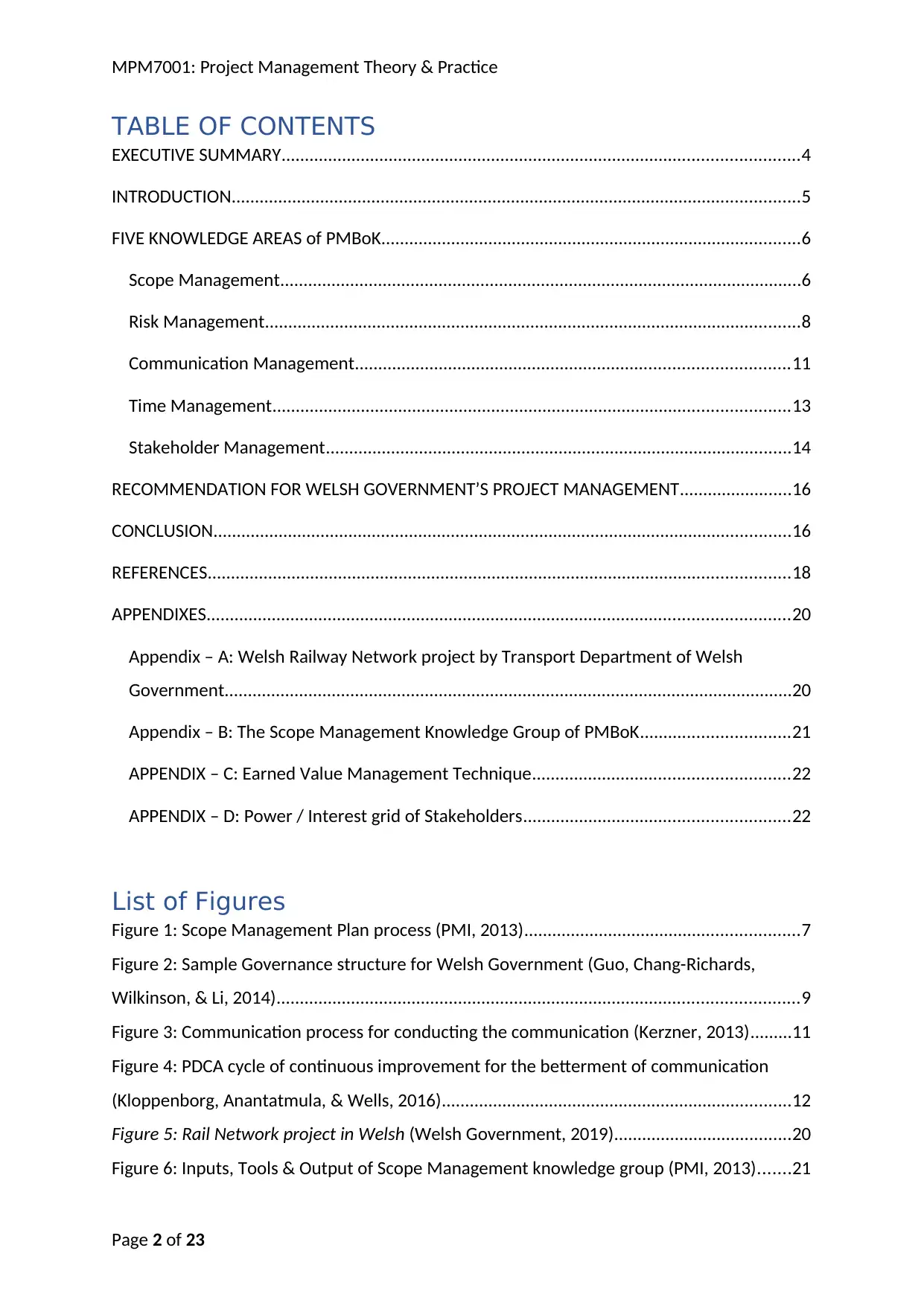
MPM7001: Project Management Theory & Practice
TABLE OF CONTENTS
EXECUTIVE SUMMARY...............................................................................................................4
INTRODUCTION..........................................................................................................................5
FIVE KNOWLEDGE AREAS of PMBoK..........................................................................................6
Scope Management................................................................................................................6
Risk Management...................................................................................................................8
Communication Management.............................................................................................11
Time Management...............................................................................................................13
Stakeholder Management....................................................................................................14
RECOMMENDATION FOR WELSH GOVERNMENT’S PROJECT MANAGEMENT........................16
CONCLUSION............................................................................................................................16
REFERENCES.............................................................................................................................18
APPENDIXES.............................................................................................................................20
Appendix – A: Welsh Railway Network project by Transport Department of Welsh
Government..........................................................................................................................20
Appendix – B: The Scope Management Knowledge Group of PMBoK................................21
APPENDIX – C: Earned Value Management Technique.......................................................22
APPENDIX – D: Power / Interest grid of Stakeholders.........................................................22
List of Figures
Figure 1: Scope Management Plan process (PMI, 2013)...........................................................7
Figure 2: Sample Governance structure for Welsh Government (Guo, Chang-Richards,
Wilkinson, & Li, 2014)................................................................................................................9
Figure 3: Communication process for conducting the communication (Kerzner, 2013).........11
Figure 4: PDCA cycle of continuous improvement for the betterment of communication
(Kloppenborg, Anantatmula, & Wells, 2016)...........................................................................12
Figure 5: Rail Network project in Welsh (Welsh Government, 2019)......................................20
Figure 6: Inputs, Tools & Output of Scope Management knowledge group (PMI, 2013).......21
Page 2 of 23
TABLE OF CONTENTS
EXECUTIVE SUMMARY...............................................................................................................4
INTRODUCTION..........................................................................................................................5
FIVE KNOWLEDGE AREAS of PMBoK..........................................................................................6
Scope Management................................................................................................................6
Risk Management...................................................................................................................8
Communication Management.............................................................................................11
Time Management...............................................................................................................13
Stakeholder Management....................................................................................................14
RECOMMENDATION FOR WELSH GOVERNMENT’S PROJECT MANAGEMENT........................16
CONCLUSION............................................................................................................................16
REFERENCES.............................................................................................................................18
APPENDIXES.............................................................................................................................20
Appendix – A: Welsh Railway Network project by Transport Department of Welsh
Government..........................................................................................................................20
Appendix – B: The Scope Management Knowledge Group of PMBoK................................21
APPENDIX – C: Earned Value Management Technique.......................................................22
APPENDIX – D: Power / Interest grid of Stakeholders.........................................................22
List of Figures
Figure 1: Scope Management Plan process (PMI, 2013)...........................................................7
Figure 2: Sample Governance structure for Welsh Government (Guo, Chang-Richards,
Wilkinson, & Li, 2014)................................................................................................................9
Figure 3: Communication process for conducting the communication (Kerzner, 2013).........11
Figure 4: PDCA cycle of continuous improvement for the betterment of communication
(Kloppenborg, Anantatmula, & Wells, 2016)...........................................................................12
Figure 5: Rail Network project in Welsh (Welsh Government, 2019)......................................20
Figure 6: Inputs, Tools & Output of Scope Management knowledge group (PMI, 2013).......21
Page 2 of 23

MPM7001: Project Management Theory & Practice
Figure 7: EVM technique which can be used by the Welsh Government for developing the
forecasts (Murphy, 2013).........................................................................................................22
Figure 8: Power & Interest grid of Stakeholders (PMI, 2013)..................................................22
List of Tables
Table 1: Requirement Traceability Matrix for tracking the needs of the project (PMI, 2013)..8
Table 2: Risk register for Welsh Government to analyse the risk (Lock, Project Management,
2007)........................................................................................................................................10
Table 3: Engagement plan Matrix of stakeholders for managing the level of engagement
(PMI, 2013)...............................................................................................................................15
Page 3 of 23
Figure 7: EVM technique which can be used by the Welsh Government for developing the
forecasts (Murphy, 2013).........................................................................................................22
Figure 8: Power & Interest grid of Stakeholders (PMI, 2013)..................................................22
List of Tables
Table 1: Requirement Traceability Matrix for tracking the needs of the project (PMI, 2013)..8
Table 2: Risk register for Welsh Government to analyse the risk (Lock, Project Management,
2007)........................................................................................................................................10
Table 3: Engagement plan Matrix of stakeholders for managing the level of engagement
(PMI, 2013)...............................................................................................................................15
Page 3 of 23
⊘ This is a preview!⊘
Do you want full access?
Subscribe today to unlock all pages.

Trusted by 1+ million students worldwide

MPM7001: Project Management Theory & Practice
EXECUTIVE SUMMARY
The main aim of developing the report is to identify the various knowledge areas present in
the project management those can be used to deliver the project flawlessly. The Welsh
Government is currently facing various complexity due to the decision which is pending to
be taken by the European Union for the fund sharing. Therefore, in such condition, the
development of project and its delivery should be managed very meticulously so that it can
be concluded as per the developed baseline schedule and cost budget. Five key knowledge
areas of project management that are the 'scope management', the 'time management', the
'risk management', the 'communication' and the 'stakeholder management' are discussed in
this report.
To deliver the project flawlessly, the appropriate scope should be developed from the
requirements after conducting appropriate prioritisation so that the chances of scope creep
and gold plating during the project execution can be minimised. Because in case of increase
in the scope, it can impact the project very negatively by increasing the resource
requirement and of course the additional cost requirement. For this purpose, the risk
present in the project should always be analysed appropriately. The risk due to the
disagreement by the European Union should always be considered before developing the
project parameters. During the identification of risk, the standard risk register as per the
Project Management concept should be used so that the probability and impact of occurring
the risk can be identified and accordingly they can be ranked during the qualitative analysis.
For executing the project flawlessly, the communication between various stakeholders
should be performed smoothly and for this purpose, the continuous improvement plan
should be incorporated during the project execution phase. It can help in reducing the effort
to communicate with different stakeholders and complete the meetings without wasting
much time. During the development of the time estimate, the bottom-up estimation
technique can be very helpful to develop an accurate estimation to develop the baseline
schedule of the project. To identify the forecast properly, the EVM technique should be
used by the project team members. The stakeholders should be managed throughout the
project life cycle by conducting the engagement plan and then executing the same during
the project execution phase. These methods can be used by the Welsh Government to
deliver the projects flawlessly.
Page 4 of 23
EXECUTIVE SUMMARY
The main aim of developing the report is to identify the various knowledge areas present in
the project management those can be used to deliver the project flawlessly. The Welsh
Government is currently facing various complexity due to the decision which is pending to
be taken by the European Union for the fund sharing. Therefore, in such condition, the
development of project and its delivery should be managed very meticulously so that it can
be concluded as per the developed baseline schedule and cost budget. Five key knowledge
areas of project management that are the 'scope management', the 'time management', the
'risk management', the 'communication' and the 'stakeholder management' are discussed in
this report.
To deliver the project flawlessly, the appropriate scope should be developed from the
requirements after conducting appropriate prioritisation so that the chances of scope creep
and gold plating during the project execution can be minimised. Because in case of increase
in the scope, it can impact the project very negatively by increasing the resource
requirement and of course the additional cost requirement. For this purpose, the risk
present in the project should always be analysed appropriately. The risk due to the
disagreement by the European Union should always be considered before developing the
project parameters. During the identification of risk, the standard risk register as per the
Project Management concept should be used so that the probability and impact of occurring
the risk can be identified and accordingly they can be ranked during the qualitative analysis.
For executing the project flawlessly, the communication between various stakeholders
should be performed smoothly and for this purpose, the continuous improvement plan
should be incorporated during the project execution phase. It can help in reducing the effort
to communicate with different stakeholders and complete the meetings without wasting
much time. During the development of the time estimate, the bottom-up estimation
technique can be very helpful to develop an accurate estimation to develop the baseline
schedule of the project. To identify the forecast properly, the EVM technique should be
used by the project team members. The stakeholders should be managed throughout the
project life cycle by conducting the engagement plan and then executing the same during
the project execution phase. These methods can be used by the Welsh Government to
deliver the projects flawlessly.
Page 4 of 23
Paraphrase This Document
Need a fresh take? Get an instant paraphrase of this document with our AI Paraphraser

MPM7001: Project Management Theory & Practice
Page 5 of 23
Page 5 of 23

MPM7001: Project Management Theory & Practice
INTRODUCTION
The Welsh Government is committed towards the society and so various projects has been
initiated by the government which can be executed to provide a better service to the citizen
of Welsh. With this concept, the government has initiated the development of a rail
network system within and outside the Welsh so that different parts of United Kingdom can
be connected to provide a smooth mode of transportation (Refer Appendix – A) (Welsh
Government, 2019). For this purpose, the railway lines are to be modified so that more
number of trains can be operated to reduce the rush during peak hours. Even various old
stations and old lines are to be modified so that a much better service and connectivity can
be provided for the people of United Kingdom. This can also improve the level of safety of
the existing stations and for this purpose, the overall budget is also being sanctioned by the
Welsh Government for the department of transport to take care about the development of
railway network system within Welsh for providing better connectivity within and rest of
places in the United Kingdom.
The project is required to be approved by the Council of Welsh government and the
Parliament because the project will be useful for the people of Welsh. The police forces
along with the armed forces can also be provided the discount facility for using the assets as
a contribution towards the community. Therefore, in this report, the different knowledge
areas present in the project management shall be discussed with respect to the above
project so that the discussed tools and processes can be used by the Welsh Government
Senior Management team to deliver the project flawlessly within the constraints. The
Transport department of the Welsh government will be the project management team of
this project. It will help in developing the project in a better way so that the scope creep and
gold plating can be avoided. Along with the time and risk management, it can also be
performed well before the start of the project. The stakeholders are also required to be
identified well. All these factors of project management shall be discussed in detail in the
subsequent sections and then the recommendation along with conclusion of the whole
report shall also be provided.
Page 6 of 23
INTRODUCTION
The Welsh Government is committed towards the society and so various projects has been
initiated by the government which can be executed to provide a better service to the citizen
of Welsh. With this concept, the government has initiated the development of a rail
network system within and outside the Welsh so that different parts of United Kingdom can
be connected to provide a smooth mode of transportation (Refer Appendix – A) (Welsh
Government, 2019). For this purpose, the railway lines are to be modified so that more
number of trains can be operated to reduce the rush during peak hours. Even various old
stations and old lines are to be modified so that a much better service and connectivity can
be provided for the people of United Kingdom. This can also improve the level of safety of
the existing stations and for this purpose, the overall budget is also being sanctioned by the
Welsh Government for the department of transport to take care about the development of
railway network system within Welsh for providing better connectivity within and rest of
places in the United Kingdom.
The project is required to be approved by the Council of Welsh government and the
Parliament because the project will be useful for the people of Welsh. The police forces
along with the armed forces can also be provided the discount facility for using the assets as
a contribution towards the community. Therefore, in this report, the different knowledge
areas present in the project management shall be discussed with respect to the above
project so that the discussed tools and processes can be used by the Welsh Government
Senior Management team to deliver the project flawlessly within the constraints. The
Transport department of the Welsh government will be the project management team of
this project. It will help in developing the project in a better way so that the scope creep and
gold plating can be avoided. Along with the time and risk management, it can also be
performed well before the start of the project. The stakeholders are also required to be
identified well. All these factors of project management shall be discussed in detail in the
subsequent sections and then the recommendation along with conclusion of the whole
report shall also be provided.
Page 6 of 23
⊘ This is a preview!⊘
Do you want full access?
Subscribe today to unlock all pages.

Trusted by 1+ million students worldwide
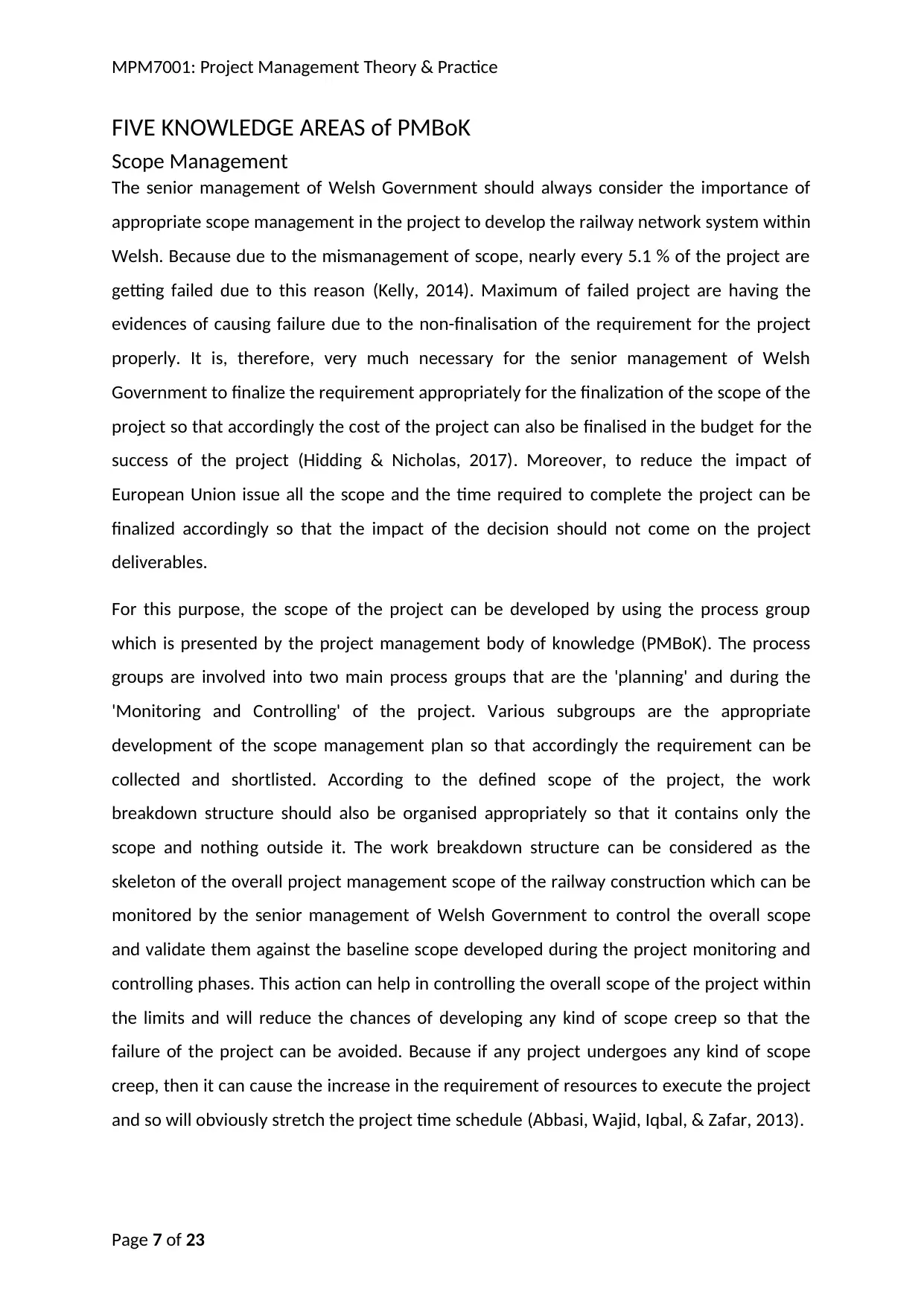
MPM7001: Project Management Theory & Practice
FIVE KNOWLEDGE AREAS of PMBoK
Scope Management
The senior management of Welsh Government should always consider the importance of
appropriate scope management in the project to develop the railway network system within
Welsh. Because due to the mismanagement of scope, nearly every 5.1 % of the project are
getting failed due to this reason (Kelly, 2014). Maximum of failed project are having the
evidences of causing failure due to the non-finalisation of the requirement for the project
properly. It is, therefore, very much necessary for the senior management of Welsh
Government to finalize the requirement appropriately for the finalization of the scope of the
project so that accordingly the cost of the project can also be finalised in the budget for the
success of the project (Hidding & Nicholas, 2017). Moreover, to reduce the impact of
European Union issue all the scope and the time required to complete the project can be
finalized accordingly so that the impact of the decision should not come on the project
deliverables.
For this purpose, the scope of the project can be developed by using the process group
which is presented by the project management body of knowledge (PMBoK). The process
groups are involved into two main process groups that are the 'planning' and during the
'Monitoring and Controlling' of the project. Various subgroups are the appropriate
development of the scope management plan so that accordingly the requirement can be
collected and shortlisted. According to the defined scope of the project, the work
breakdown structure should also be organised appropriately so that it contains only the
scope and nothing outside it. The work breakdown structure can be considered as the
skeleton of the overall project management scope of the railway construction which can be
monitored by the senior management of Welsh Government to control the overall scope
and validate them against the baseline scope developed during the project monitoring and
controlling phases. This action can help in controlling the overall scope of the project within
the limits and will reduce the chances of developing any kind of scope creep so that the
failure of the project can be avoided. Because if any project undergoes any kind of scope
creep, then it can cause the increase in the requirement of resources to execute the project
and so will obviously stretch the project time schedule (Abbasi, Wajid, Iqbal, & Zafar, 2013).
Page 7 of 23
FIVE KNOWLEDGE AREAS of PMBoK
Scope Management
The senior management of Welsh Government should always consider the importance of
appropriate scope management in the project to develop the railway network system within
Welsh. Because due to the mismanagement of scope, nearly every 5.1 % of the project are
getting failed due to this reason (Kelly, 2014). Maximum of failed project are having the
evidences of causing failure due to the non-finalisation of the requirement for the project
properly. It is, therefore, very much necessary for the senior management of Welsh
Government to finalize the requirement appropriately for the finalization of the scope of the
project so that accordingly the cost of the project can also be finalised in the budget for the
success of the project (Hidding & Nicholas, 2017). Moreover, to reduce the impact of
European Union issue all the scope and the time required to complete the project can be
finalized accordingly so that the impact of the decision should not come on the project
deliverables.
For this purpose, the scope of the project can be developed by using the process group
which is presented by the project management body of knowledge (PMBoK). The process
groups are involved into two main process groups that are the 'planning' and during the
'Monitoring and Controlling' of the project. Various subgroups are the appropriate
development of the scope management plan so that accordingly the requirement can be
collected and shortlisted. According to the defined scope of the project, the work
breakdown structure should also be organised appropriately so that it contains only the
scope and nothing outside it. The work breakdown structure can be considered as the
skeleton of the overall project management scope of the railway construction which can be
monitored by the senior management of Welsh Government to control the overall scope
and validate them against the baseline scope developed during the project monitoring and
controlling phases. This action can help in controlling the overall scope of the project within
the limits and will reduce the chances of developing any kind of scope creep so that the
failure of the project can be avoided. Because if any project undergoes any kind of scope
creep, then it can cause the increase in the requirement of resources to execute the project
and so will obviously stretch the project time schedule (Abbasi, Wajid, Iqbal, & Zafar, 2013).
Page 7 of 23
Paraphrase This Document
Need a fresh take? Get an instant paraphrase of this document with our AI Paraphraser
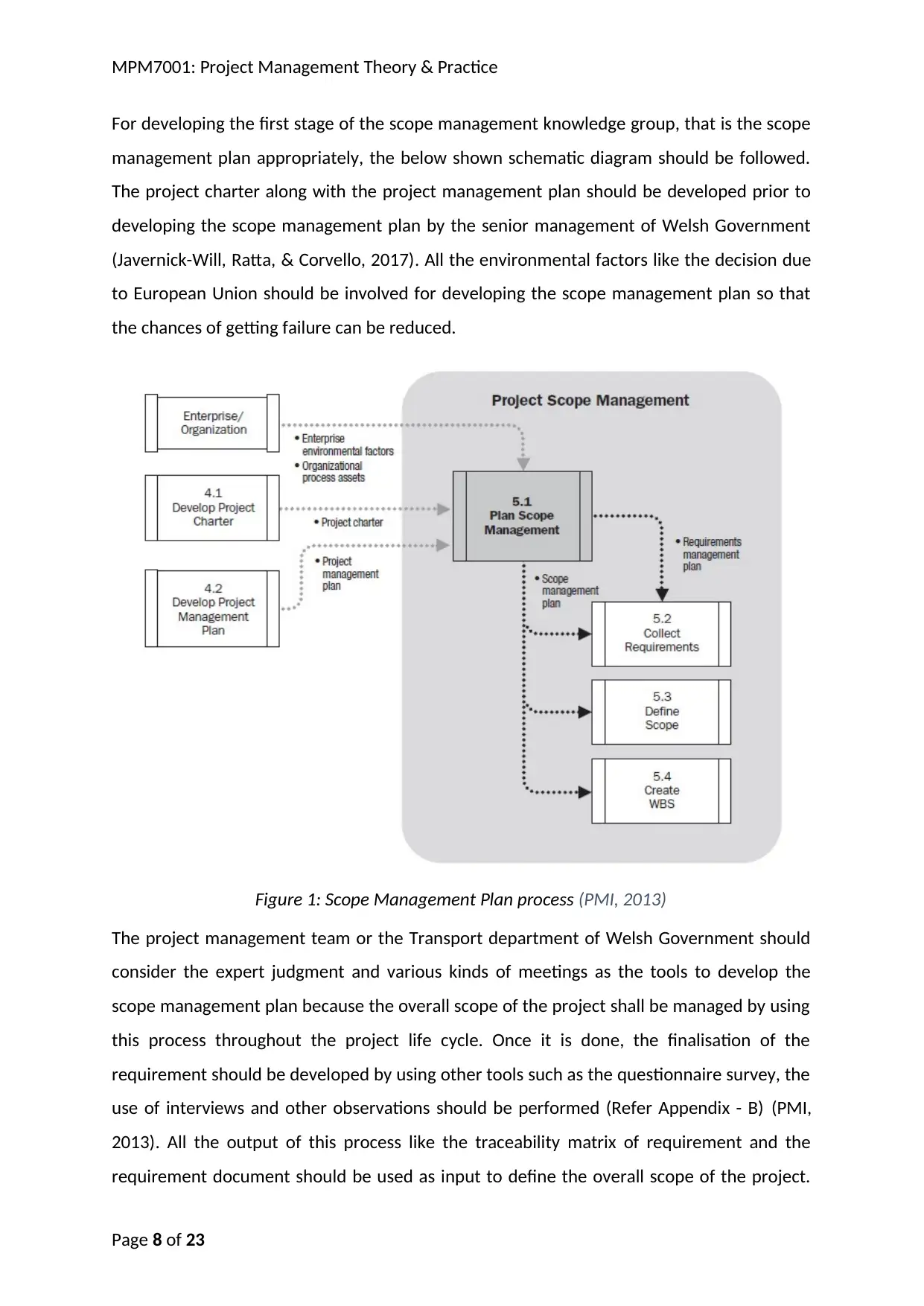
MPM7001: Project Management Theory & Practice
For developing the first stage of the scope management knowledge group, that is the scope
management plan appropriately, the below shown schematic diagram should be followed.
The project charter along with the project management plan should be developed prior to
developing the scope management plan by the senior management of Welsh Government
(Javernick-Will, Ratta, & Corvello, 2017). All the environmental factors like the decision due
to European Union should be involved for developing the scope management plan so that
the chances of getting failure can be reduced.
Figure 1: Scope Management Plan process (PMI, 2013)
The project management team or the Transport department of Welsh Government should
consider the expert judgment and various kinds of meetings as the tools to develop the
scope management plan because the overall scope of the project shall be managed by using
this process throughout the project life cycle. Once it is done, the finalisation of the
requirement should be developed by using other tools such as the questionnaire survey, the
use of interviews and other observations should be performed (Refer Appendix - B) (PMI,
2013). All the output of this process like the traceability matrix of requirement and the
requirement document should be used as input to define the overall scope of the project.
Page 8 of 23
For developing the first stage of the scope management knowledge group, that is the scope
management plan appropriately, the below shown schematic diagram should be followed.
The project charter along with the project management plan should be developed prior to
developing the scope management plan by the senior management of Welsh Government
(Javernick-Will, Ratta, & Corvello, 2017). All the environmental factors like the decision due
to European Union should be involved for developing the scope management plan so that
the chances of getting failure can be reduced.
Figure 1: Scope Management Plan process (PMI, 2013)
The project management team or the Transport department of Welsh Government should
consider the expert judgment and various kinds of meetings as the tools to develop the
scope management plan because the overall scope of the project shall be managed by using
this process throughout the project life cycle. Once it is done, the finalisation of the
requirement should be developed by using other tools such as the questionnaire survey, the
use of interviews and other observations should be performed (Refer Appendix - B) (PMI,
2013). All the output of this process like the traceability matrix of requirement and the
requirement document should be used as input to define the overall scope of the project.
Page 8 of 23

MPM7001: Project Management Theory & Practice
The matrix should have all the basic requirement related to the needs according to the
project and the description along with the stakeholder who has raised the requirement as
per the below-provided table.
Table 1: Requirement Traceability Matrix for tracking the needs of the project (PMI, 2013)
After this, the work breakdown structure can be developed by using the decomposition tool
by developing the step-down approach for the division of the overall scope into various
levels of work packages.
Risk Management
There are various types of risk those are present for executing the projects by the Welsh
Government due to the environmental factors like the decision of European Union. There
are various kinds of financial risk that the Welsh Government can face due to the structuring
of the European Union. Because as per the agreement, the EU will pay 2.1 billion Euro and in
addition to this, there can be around 1.1 billion Euro of contribution due to match funding
(Cymru, 2018). While considering the analysis of risk, these financial factors should always
be considered in detail while conducting one of the process activity from the risk
management knowledge area.
The risk management knowledge area is being performed during three process groups of
PMBoK that are the planning, the execution, and during the monitoring and controlling
Page 9 of 23
The matrix should have all the basic requirement related to the needs according to the
project and the description along with the stakeholder who has raised the requirement as
per the below-provided table.
Table 1: Requirement Traceability Matrix for tracking the needs of the project (PMI, 2013)
After this, the work breakdown structure can be developed by using the decomposition tool
by developing the step-down approach for the division of the overall scope into various
levels of work packages.
Risk Management
There are various types of risk those are present for executing the projects by the Welsh
Government due to the environmental factors like the decision of European Union. There
are various kinds of financial risk that the Welsh Government can face due to the structuring
of the European Union. Because as per the agreement, the EU will pay 2.1 billion Euro and in
addition to this, there can be around 1.1 billion Euro of contribution due to match funding
(Cymru, 2018). While considering the analysis of risk, these financial factors should always
be considered in detail while conducting one of the process activity from the risk
management knowledge area.
The risk management knowledge area is being performed during three process groups of
PMBoK that are the planning, the execution, and during the monitoring and controlling
Page 9 of 23
⊘ This is a preview!⊘
Do you want full access?
Subscribe today to unlock all pages.

Trusted by 1+ million students worldwide
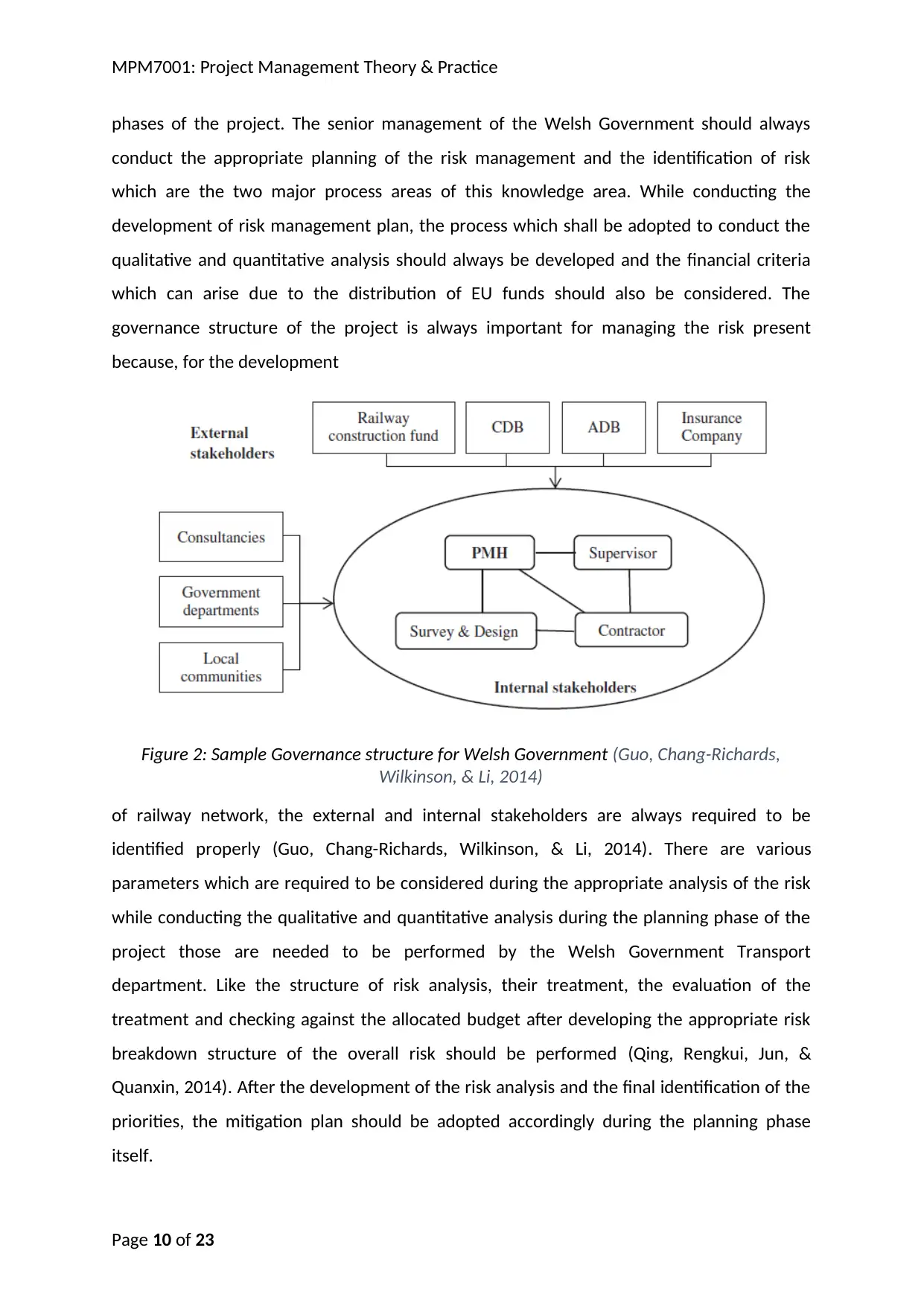
MPM7001: Project Management Theory & Practice
phases of the project. The senior management of the Welsh Government should always
conduct the appropriate planning of the risk management and the identification of risk
which are the two major process areas of this knowledge area. While conducting the
development of risk management plan, the process which shall be adopted to conduct the
qualitative and quantitative analysis should always be developed and the financial criteria
which can arise due to the distribution of EU funds should also be considered. The
governance structure of the project is always important for managing the risk present
because, for the development
Figure 2: Sample Governance structure for Welsh Government (Guo, Chang-Richards,
Wilkinson, & Li, 2014)
of railway network, the external and internal stakeholders are always required to be
identified properly (Guo, Chang-Richards, Wilkinson, & Li, 2014). There are various
parameters which are required to be considered during the appropriate analysis of the risk
while conducting the qualitative and quantitative analysis during the planning phase of the
project those are needed to be performed by the Welsh Government Transport
department. Like the structure of risk analysis, their treatment, the evaluation of the
treatment and checking against the allocated budget after developing the appropriate risk
breakdown structure of the overall risk should be performed (Qing, Rengkui, Jun, &
Quanxin, 2014). After the development of the risk analysis and the final identification of the
priorities, the mitigation plan should be adopted accordingly during the planning phase
itself.
Page 10 of 23
phases of the project. The senior management of the Welsh Government should always
conduct the appropriate planning of the risk management and the identification of risk
which are the two major process areas of this knowledge area. While conducting the
development of risk management plan, the process which shall be adopted to conduct the
qualitative and quantitative analysis should always be developed and the financial criteria
which can arise due to the distribution of EU funds should also be considered. The
governance structure of the project is always important for managing the risk present
because, for the development
Figure 2: Sample Governance structure for Welsh Government (Guo, Chang-Richards,
Wilkinson, & Li, 2014)
of railway network, the external and internal stakeholders are always required to be
identified properly (Guo, Chang-Richards, Wilkinson, & Li, 2014). There are various
parameters which are required to be considered during the appropriate analysis of the risk
while conducting the qualitative and quantitative analysis during the planning phase of the
project those are needed to be performed by the Welsh Government Transport
department. Like the structure of risk analysis, their treatment, the evaluation of the
treatment and checking against the allocated budget after developing the appropriate risk
breakdown structure of the overall risk should be performed (Qing, Rengkui, Jun, &
Quanxin, 2014). After the development of the risk analysis and the final identification of the
priorities, the mitigation plan should be adopted accordingly during the planning phase
itself.
Page 10 of 23
Paraphrase This Document
Need a fresh take? Get an instant paraphrase of this document with our AI Paraphraser
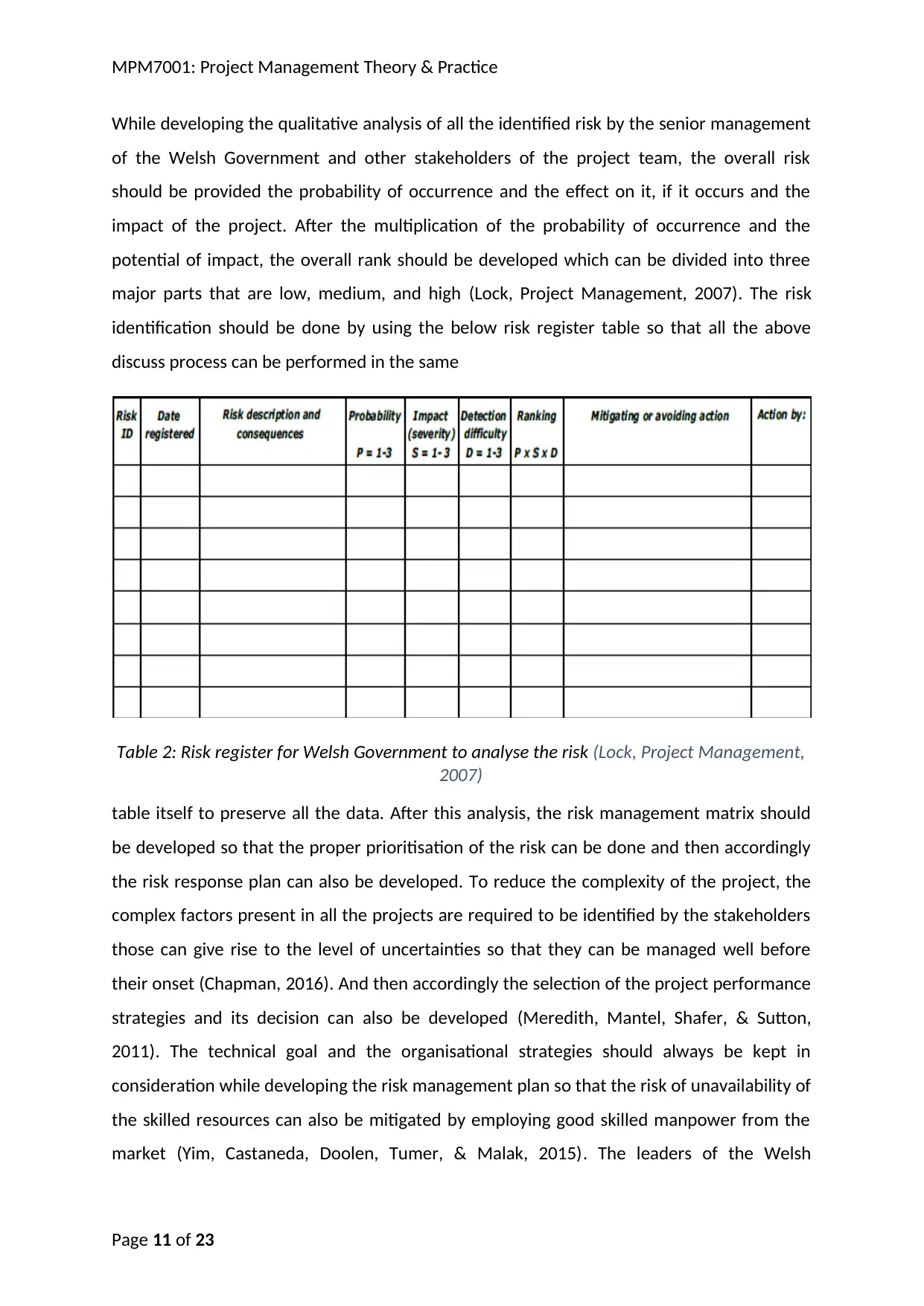
MPM7001: Project Management Theory & Practice
While developing the qualitative analysis of all the identified risk by the senior management
of the Welsh Government and other stakeholders of the project team, the overall risk
should be provided the probability of occurrence and the effect on it, if it occurs and the
impact of the project. After the multiplication of the probability of occurrence and the
potential of impact, the overall rank should be developed which can be divided into three
major parts that are low, medium, and high (Lock, Project Management, 2007). The risk
identification should be done by using the below risk register table so that all the above
discuss process can be performed in the same
Table 2: Risk register for Welsh Government to analyse the risk (Lock, Project Management,
2007)
table itself to preserve all the data. After this analysis, the risk management matrix should
be developed so that the proper prioritisation of the risk can be done and then accordingly
the risk response plan can also be developed. To reduce the complexity of the project, the
complex factors present in all the projects are required to be identified by the stakeholders
those can give rise to the level of uncertainties so that they can be managed well before
their onset (Chapman, 2016). And then accordingly the selection of the project performance
strategies and its decision can also be developed (Meredith, Mantel, Shafer, & Sutton,
2011). The technical goal and the organisational strategies should always be kept in
consideration while developing the risk management plan so that the risk of unavailability of
the skilled resources can also be mitigated by employing good skilled manpower from the
market (Yim, Castaneda, Doolen, Tumer, & Malak, 2015). The leaders of the Welsh
Page 11 of 23
While developing the qualitative analysis of all the identified risk by the senior management
of the Welsh Government and other stakeholders of the project team, the overall risk
should be provided the probability of occurrence and the effect on it, if it occurs and the
impact of the project. After the multiplication of the probability of occurrence and the
potential of impact, the overall rank should be developed which can be divided into three
major parts that are low, medium, and high (Lock, Project Management, 2007). The risk
identification should be done by using the below risk register table so that all the above
discuss process can be performed in the same
Table 2: Risk register for Welsh Government to analyse the risk (Lock, Project Management,
2007)
table itself to preserve all the data. After this analysis, the risk management matrix should
be developed so that the proper prioritisation of the risk can be done and then accordingly
the risk response plan can also be developed. To reduce the complexity of the project, the
complex factors present in all the projects are required to be identified by the stakeholders
those can give rise to the level of uncertainties so that they can be managed well before
their onset (Chapman, 2016). And then accordingly the selection of the project performance
strategies and its decision can also be developed (Meredith, Mantel, Shafer, & Sutton,
2011). The technical goal and the organisational strategies should always be kept in
consideration while developing the risk management plan so that the risk of unavailability of
the skilled resources can also be mitigated by employing good skilled manpower from the
market (Yim, Castaneda, Doolen, Tumer, & Malak, 2015). The leaders of the Welsh
Page 11 of 23

MPM7001: Project Management Theory & Practice
Government and the Transport department of the government should always develop the
soft skill of managing the risk by executing the appropriate communication skill so that the
information can be shared properly (Carvalho & Junior, 2015). According to the level of
complexity of achieving the success of the project, the level of soft skill should be used to
manage the project responses during the execution phase of the project.
Communication Management
It is the knowledge area which is always being performed during the project planning and
continues up to the phase before the close out of the project. In this process various types
of information are being shared with the stakeholders by using verbal or nonverbal
communication (APM, 2006). Due to the risk of the exit of the Brexit from the EU, the Welsh
Government also has the risk of getting de-associated from the EU. Therefore, in such
condition, the stakeholders of the project can get changed and so the communication
channel will also get changed accordingly. But as of now, to execute the project, the
communication channels should be developed after the identification of the stakeholders
properly (in stakeholder management knowledge area).
It is a process in which the sender of the information sends the message through media like
the internet services or verbally and then it is decoded by the receiver. The receiver again
sends back the feedback to the centre to make the communication effective (Taleb, Ismail,
Wahab, Rani, & Amat, 2017). This knowledge area is also being used during three phases
that
Page 12 of 23
Government and the Transport department of the government should always develop the
soft skill of managing the risk by executing the appropriate communication skill so that the
information can be shared properly (Carvalho & Junior, 2015). According to the level of
complexity of achieving the success of the project, the level of soft skill should be used to
manage the project responses during the execution phase of the project.
Communication Management
It is the knowledge area which is always being performed during the project planning and
continues up to the phase before the close out of the project. In this process various types
of information are being shared with the stakeholders by using verbal or nonverbal
communication (APM, 2006). Due to the risk of the exit of the Brexit from the EU, the Welsh
Government also has the risk of getting de-associated from the EU. Therefore, in such
condition, the stakeholders of the project can get changed and so the communication
channel will also get changed accordingly. But as of now, to execute the project, the
communication channels should be developed after the identification of the stakeholders
properly (in stakeholder management knowledge area).
It is a process in which the sender of the information sends the message through media like
the internet services or verbally and then it is decoded by the receiver. The receiver again
sends back the feedback to the centre to make the communication effective (Taleb, Ismail,
Wahab, Rani, & Amat, 2017). This knowledge area is also being used during three phases
that
Page 12 of 23
⊘ This is a preview!⊘
Do you want full access?
Subscribe today to unlock all pages.

Trusted by 1+ million students worldwide
1 out of 23
Related Documents
Your All-in-One AI-Powered Toolkit for Academic Success.
+13062052269
info@desklib.com
Available 24*7 on WhatsApp / Email
![[object Object]](/_next/static/media/star-bottom.7253800d.svg)
Unlock your academic potential
Copyright © 2020–2026 A2Z Services. All Rights Reserved. Developed and managed by ZUCOL.





